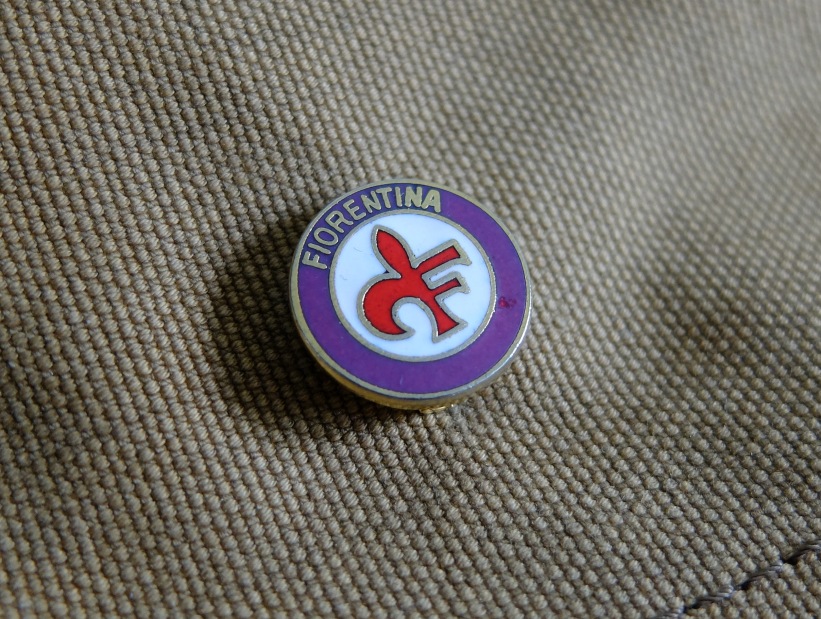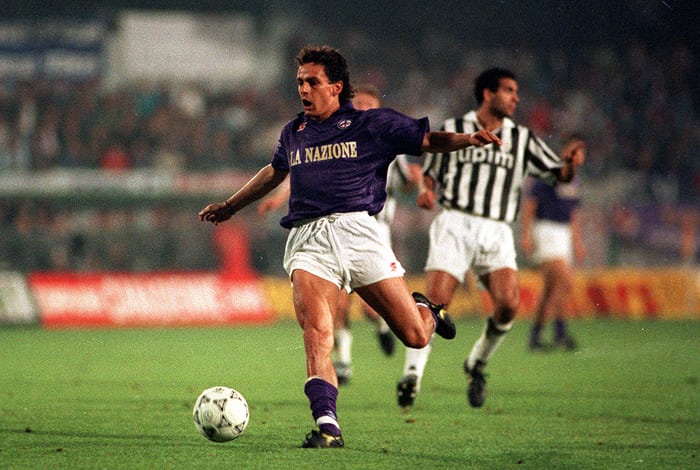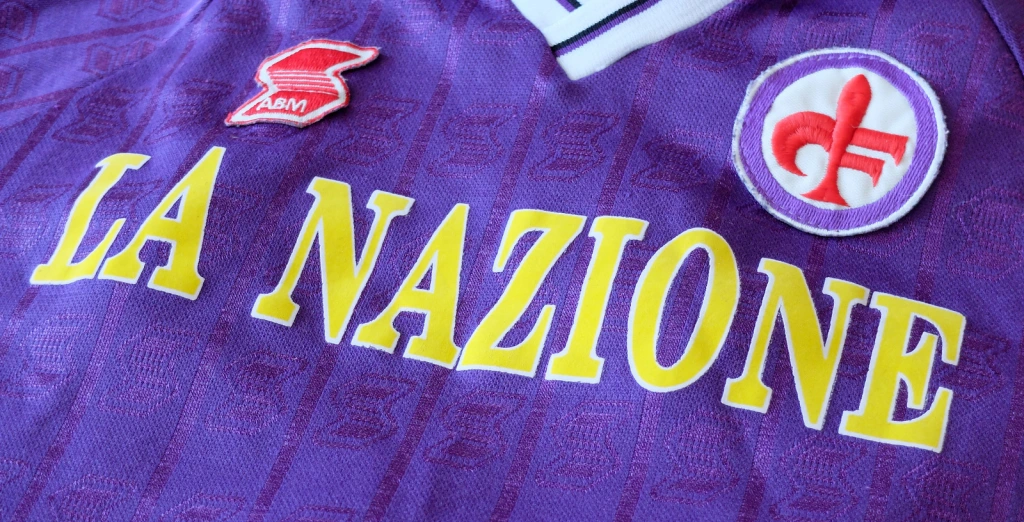Shirt: Fiorentina (home)
Season: 1988-90
Manufacturer: ABM
Sponsor: Crodino/La Nazione
Worn by: Roberto Baggio, Dunga, Stefano Borgonovo, Glenn Hysén, Alberto Di Chiara, Oscar Dertycia, Luboš Kubík, Giuseppe Volpecina, Renato Buso.
In 1980, construction magnate Flavio Pontello assumed control of Fiorentina, appointing his son, Ranieri, as president. Within a year, he’d changed the club’s badge and struck a deal with the clothing company JD Farrow’s to sponsor the kit, which was not the done thing in Italy back then. The new circular emblem comprised of half a fleur-de-lis (a stylised lily, or giglio) appended to the letter F, taking on the appearance of a halberd, and was displayed in the middle of a red-trimmed shirt, occupying a fair proportion of it, with the club’s sponsor transcribed above. Fiorentina’s new look was not popular, but when Pontello started investing in actual players, opinions softened. In 1981/82 they achieved second place, and would probably have won the championship had a goal not been controversially disallowed against Caligari in the last game of the season, handing their arch-rivals Juventus the title.

The new club emblem comprised of a stylised lily, or giglio, appended to the letter F
Thereafter, Fiorentina’s form was inconsistent: in 1983 they finished fifth, in ‘84 third, and in ‘85 ninth. Meanwhile, Ennerre had taken over as kit supplier and set about reducing the size of the club’s crest, whilst also accommodating car manufacturer Opel as the team sponsor.
For 1985/86, Ennerre developed a strip that could itself be considered iconic. The garish, red trim was discarded, and the badge moved to the more usual position over the left breast. This made room for Ennerre’s wonderfully minimal (green) insignia on the right, while the sponsor was set against a white band that wrapped around the trunk of the shirt. (Unfortunately, the enigmatic Brazilian, Sócrates, didn’t hang around long enough to play in this strip, although there are images of him wearing it, presumably on the training field before returning to Brazil.)
Socrates pictured with Daniele Massaro during the 84-85 season
Fiorentina managed a respectable fourth place, although it’s probably worth pointing out that they drew 13 of their 30 matches, which wouldn’t now place them quite so high (at the time, two points were awarded for a win, inflating the value of a drawn game). Moreover, their top scorer was the defender Daniel Passarella, prompting Inter to divest Fiorentina of the player’s services.
For what would be club captain Giancarlo Antognoni’s final year at Fiorentina, Ennerre handed over shirt making responsibilities to the their subsidiary brand, N2 (any background on this would be most welcome). As good as Ennerre/N2 shirts looked, the company were slow to embrace contemporary textiles, preferring a cotton/wool blend called lanetta, which wasn’t ideal in and hot and/or humid conditions. Fiorentina finished a disappointing tenth in 1986/87, although new signing Ramon Diaz had impressed with 10 goals, Nicola Berti was looking like good value after his transfer from Parma in 1985, and it appeared that Roberto Baggio had finally recovered from the injury that had hampered him for the best part of a year.
The situation in 1988 looked precarious. Antognoni had moved to Swiss club FC Lausanne-Sport to see out his career, while Berti and Diaz had both signed for Trapattoni‘s Inter. Incoming players included defensive-midfielder Dunga, signed from Pisa, and striker Stefano Borgonovo, taken on loan from AC Milan.
At the same time, ABM became the kit supplier. Entirely purple, the new shirt was micro-patterned, creating subtle shifts in the fabric’s texture to make a pattern out of the manufacturer’s logo. The club had a different sponsor too – non-alcoholic aperitif Crodino. There was, however, a problem. The purple shirt was to be worn with purple shorts. Moreover, these shorts, as is often the case, were made from a contrasting material. The effect was that Fiorentina weren’t actually playing in the same colour, but in two shades of the same colour, and two shades of a colour as vivid as purple. Mercifully, socks remained white.
Fiorentina did all right, finishing Serie A in eighth place and reaching the quarter finals of the Coppa Italia. Rather fortuitously, AC Milan went on to win the European Cup and Sampdoria the Coppa Italia, effectively freeing up an extra place in UEFA Cup, which went to Fiorentina after they defeated Roma in a play-off. Even more auspicious was the fact that Baggio and Borgonovo had formed a very effective partnership – as well as a close friendship – scoring 15 and 14 goals respectively. Or it would have been if AC Milan didn’t then recall their man to provide cover for Marco Van Basten.
Baggio in resplendent purple.
For 1989/90, Fiorentina were issued with white shorts and purple socks. It is this iteration of the ABM strip that is by far the best, and that can rightly be regarded as a true ‘calcio classic’. Local rag La Nazione took over as sponsor, their uppercase, serif-font emblazoned in yellow (yellow being the complimentary colour of purple). It should be appreciated that the red parallelograms that constitute the ABM logo probably worked better with the modern logo than they would have against the more traditional fleur-de-lis. This being the end the 1980s, the shirt was not overly baggy and could flatter a variety of physiques.
Fiorentina replaced Borgonovo with Argentine striker Oscar Dertycia, as well as bringing in Czech midfielder Luboš Kubík, winger Renato Buso, and defender Giuseppe Volpecina, among others. The results were mixed. On the one hand, Fiorentina only just avoided relegation after beating Atalanta on the last day of the season. On the other, they reached the UEFA Cup final, controversially losing to Juventus 3-1 over two legs; Fiorentina were forced to play their home leg in Avellino, despite having played the rest of their European campaign in Perugia, which was far closer to home (Stadio Artemio Franchi was undergoing refurbishment prior to the 1990 World Cup and was not judged fit for European competition). Nonetheless, the images of Roberto Baggio – playing his last game for the club – and the rest of the team, resplendent in purple and white, are some of Fiorentina’s finest.
ABM hung around for another year but reverted to issuing purple shorts, as well as adding white trim to the neck-line. In 1991, Lotto took over, and all was lost. Not only did white shorts go for good, but so did Pontello’s giglio. In an era where clubs’ re-design their insignias with mild regularity, one can only hope it might one day make a return.
Words by James Evans: @JDEvans75
For vintage and match-worn Fiorentina shirts click here


